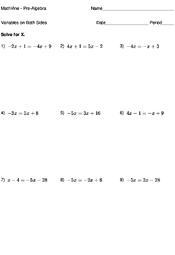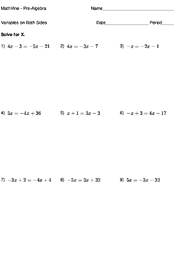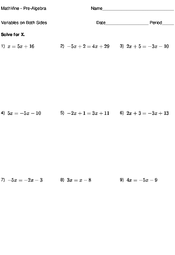Solving Equations with Variables on Both Sides
Introduction
Variables are letters in an equation that represent a particular quantity. Solving an equation with a single variable just means putting the variable on one side and the numbers on the other.
If you have an equation with variables on both sides, you will need to move the terms around, so that you have both variables on one side, and all the numbers on the other.
Terms
Lesson
If you have an equation like:
You need to get all of the like terms together on the same side of the equals sign. So, we want all of the a values on the right, and all of the non-a values on the left.
To 'move' values around the equation, we need to cancel them out on one side of the equation. Since we have to do the same thing to both sides of the equation or it won't be balanced, we 'move' a value by reversing its sign (positive to negative, and negative to positive) and then either adding it or subtracting it from both sides. To move a 2 from one side of the equation to the other, we would subtract 2 from both sides.
The first step to take is to subtract 2a from both sides.
Then we add 1 to both sides to move the -1 to the left side of the equals sign:
Therefore, a = 7. We can check this by plugging it into the original equation:
Therefore, 7 is the correct value for a.
When you move like terms, the golden rule is to cancel it out by adding or subtracting its reverse from both sides of the equation. Once you can do that easily, you will have no problems shuffling the variables to make them simpler.
Remember also that you can only combine like terms - you can't combine 2a and 3b, or 2a and 5.


